Search results for: 'Ring'
-
 Antiker Ring
Antiker RingBronzering, etwa 5. bis 1. Jh. v. Chr., keltisch.
Price: on request Celtic neck ring
Celtic neck ringOpen ring made of solid bronze. The torc is from Gaul or Central Europe and dates to the 4th or 3rd century BC.
Price: on request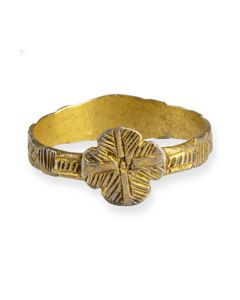 Medieval gilt finger ring
Medieval gilt finger ringThe ring from the late Middle Ages was found in England. The silver body and the gold plating are in excellent condition. Appraised at the British Museum, published in the Portable Antiquities Scheme database.
Price: on request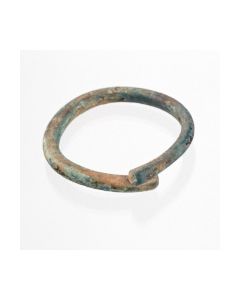 Ring aus der Bronzezeit
Ring aus der BronzezeitEleganter Schmuckring mit überlappenden Enden. Türkisfarbene Bronzepatina.
Price: on request Neck ring of the Urnfield culture
Neck ring of the Urnfield cultureThis bronze ring is an early variant of a torc. The piece of jewellery was found in Southern Germany and dates to the Late Bronze Age.
Price: on request Schmuckring aus Bronze
Schmuckring aus BronzeKreisförmiger Ring mit Überlapp. Die Oberfläche ist dezent mit einem Rillendekor verziert. Schön erhaltenes Exemplar mit lebhafter Patina.
Price: on request Roman gold fingerring
Roman gold fingerringNice piece of jewellery from the later Roman Imperial period. With beaded wires and intaglio. Found in England.
€2,400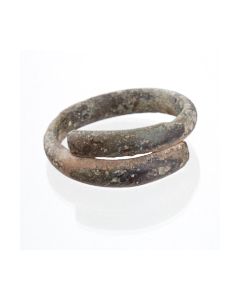 Schmuckring aus der Bronzezeit
Schmuckring aus der BronzezeitMassiver Schmuckring mit überlappenden Enden. Dunkle Patina.
Price: on request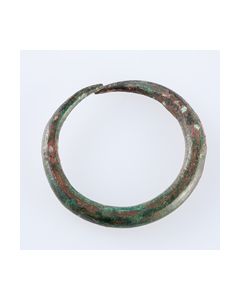 Römischer Ohrring
Römischer OhrringMassiver Ohrschmuck aus der römischen Epoche. Perfekte Erhaltung, schöne Patina. Aus alter deutscher Sammlung.
Price: on request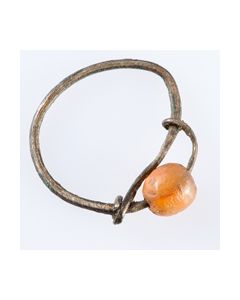 römischer Ohrring mit Bernstein
römischer Ohrring mit BernsteinBronze-Ohrring mit Bernsteinperle, perfekt erhalten, aus alter deutscher Sammlung.
Price: on request Massive Roman oil lamp - found in Lopodunum, Germany
Massive Roman oil lamp - found in Lopodunum, GermanyNicely preserved piece from the earliest Roman settlement phase
Price: on request Roman firma lamp with handle
Roman firma lamp with handleAcquired in the 1960s at Hermann Zirkel Gallery, Cologne, Germany. Perfectly preserved including the dark red slip.
Price: on request Roman oil lamp - found in Lopodunum, Germany
Roman oil lamp - found in Lopodunum, GermanyPerfectly preserved piece from the earliest Roman settlement phase
Price: on request Bronze Age bracelet with incised decoration
Bronze Age bracelet with incised decorationThe jewellery was made in Europe during the 2nd millennium BC. Nice, dark patina.
Price: on request Small Roman oil lamp - found in Lopodunum, Germany
Small Roman oil lamp - found in Lopodunum, GermanyNicely preserved piece from the earliest Roman settlement phase
Price: on request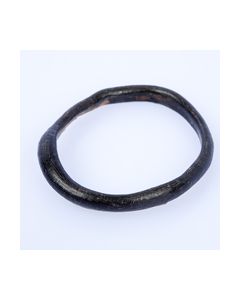 Kinderarmreif aus dunklem Glas
Kinderarmreif aus dunklem GlasRömische Epoche, hervorragend erhalten. Aus alter deutscher Sammlung.
Price: on request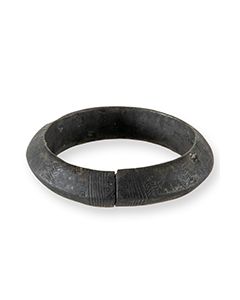 Bronze Age bracelet with incised decoration
Bronze Age bracelet with incised decorationThe jewellery was made in Europe during the 2nd millennium BC. Nice, dark patina.
Price: on request Römischer Armreif aus grünem Glas
Römischer Armreif aus grünem GlasRömische Epoche, schöne Farbgebung.
Price: on request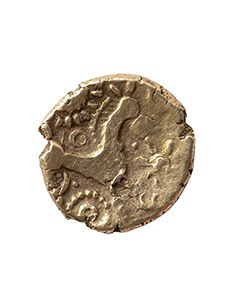 Extremely rare Celtic gold stater of Regni tribe
Extremely rare Celtic gold stater of Regni tribeFound 2015 in Winterbourne, West Berkshire, UK. Registered with the Portable Antiquities Scheme, reference BERK-1FC826.
Price: on request Roman oil lamp found in Regensburg area
Roman oil lamp found in Regensburg areaWith makers mark QGC. Found in Southern Germany. From the collection of Hugo Rehorik (1905-1979), a voluntary archeologist who was working in the Regensburg area in the 1960s and 1970s.
Price: on request Spoked disc brooch from Roman Britain
Spoked disc brooch from Roman BritainThis is an extremely rare variant native to Roman Britain. Hattatt mentions that only 13 specimen of this type are known to exist.
Price: on request Celtic penannular brooch
Celtic penannular broochPossibly made by the Celtic Durotriges tribe under Roman rule in Britain. The piece is published in two books by Richard Hattatt.
Price: on request Roman plate brooch
Roman plate broochBeautiful example with orange and turquoise enamel. A find from 2nd century Roman Britain.
Price: on request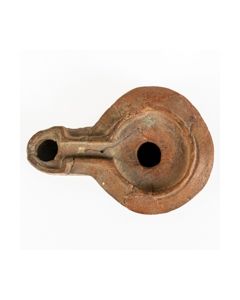 Roman oil lamp found in Regensburg area
Roman oil lamp found in Regensburg areaWith makers mark FESTI A. Found in Southern Germany. From the collection of Hugo Rehorik (1905-1979), a voluntary archeologist who was working in the Regensburg area in the 1960s and 1970s.
Price: on request Roman rosette brooch from Colchester
Roman rosette brooch from ColchesterA nice brooch type from the 1st century with an especially well preserved decorative disc. From the famous Hattatt collection and published in two standard works on ancient brooches.
Price: on request Gesichtsurne der Lausitzer-Kultur
Gesichtsurne der Lausitzer-KulturSeltenes anthropomorphes Gefäß, 1300 bis 500 v. Chr. Eindrucksvolle 24cm hoch. Komplett erhalten mit Deckel. Aus der Sammlung Dr. Rüssmann.
Price: on request Gesichtsurne mit Deckel, Lausitzer Kultur
Gesichtsurne mit Deckel, Lausitzer KulturÄußerst seltener und beliebter Gefäßtyp der Lausitzer Kultur. Etwa 1300 bis 500 v. Chr., Übergang zwischen Bronze- und Eisenzeit in Europa. Komplett erhalten, inklusive Deckel.
Price: on request

